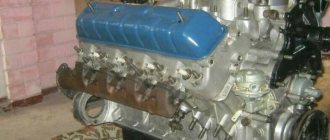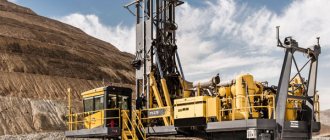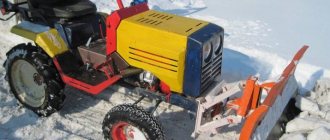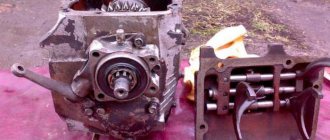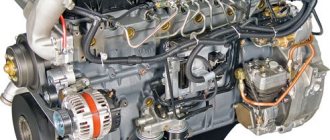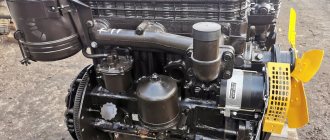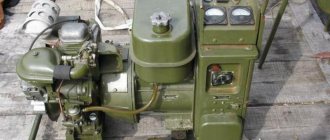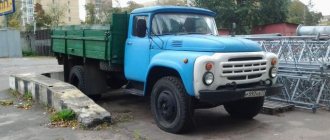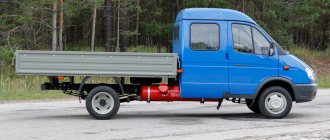The largest Russian manufacturer of diesel engines
In 1916, in the city of Yaroslavl, an enterprise for the production of passenger cars was created by engineer V. A. Lebedev. The further development of the plant is associated with the production of trucks, the production of which began in 1925. At that time, these were heavy-duty models with a lifting capacity of up to 7 tons.
Subsequently, the company began to manufacture dump trucks, buses and trolleybuses. In the early fifties, the plant mastered the serial production of diesel engines. The year 1958 should be considered an important stage of development. This year, the enterprise was repurposed to produce diesel power units and received the name “Yaroslavl Motor Plant”.
The established plant immediately began developing a new line of diesel engines for a wide variety of equipment. In 1961, serial production of diesel models YaMZ-236, YaMZ-238, YaMZ-240 began. The engines differed in power due to the use of a different number of cylinders (from 6 to 10), which made it possible to install the engines on a wide variety of equipment, but at the same time they had great unification, which simplified maintenance and possible repairs.
YaMZ products
Currently, the YaMZ enterprise (Avtodiesel) is part of the GAZ Group automobile concern and specializes in the production of the following products:
- medium and heavy diesel engines;
- gearboxes and clutches for assembly with manufactured diesel engines;
- diesel electric units;
- spare parts.
Manufactured diesel power units have a variety of technical parameters:
- power – 120.0-800.0 l. With.;
- volume – 4.45-26.0 l;
- execution options: L-shaped (in-line), V-shaped.
Such a variety of engines, modern design, and operational parameters have ensured that the Yaroslavl motor is widely used in various commercial equipment.
Application of YaMZ-238 engines
The company's product range currently includes 38 modifications of V-shaped eight-cylinder engines for various purposes, 22 of which are models based on YaMZ-238.
This use was ensured by the high-quality design and technical characteristics of the YaMZ-238 engine, which made it possible to modernize the engine. At the moment, power units are installed on the following types of equipment: Table 1
| No. | Modification designation | Installation technique | Manufacturer |
| 1 | DE2 | Harvesters | "Gomselmash" |
| 2 | BE2 | Combines, tractors, pipe layers | "Promtractors", "Gomselmash", "ChSDM" |
| 3 | DE2 (EURO-2) | Trucks, combines | "MAZ", "Gomselmash" |
| 4 | DE | Trucks, chassis | "MAZ", "URAL" |
| 5 | ND6 | Front loaders | "Petersburg Tractor Plant" |
| 6 | ND7 | Tractors, pipe layers | ""Petersburg Tractor Plant", "Promtractor" |
| 7 | ND8 | Tractors | "Petersburg Tractor Plant" |
| 8 | B | Dump trucks, tractors, excavators, trucks, track machines | "BelAZ", "MoAZ", "MAZ", "Promtractor", "URAL", "KRANEKS", "VEKS", "Kalugaputmash" |
| 9 | BV | Transporter tractors | "Rubtsovsky Machine-Building Plant" |
| 10 | BC | Harvesters | "Gomselmash" |
| 11 | BL | Crawler tractor | "Muromteplovoz" |
| 12 | BN | Mine dump truck | "MoAZ" |
| 13 | D | Trucks, skidders, pipe layers | "MAZ", "Kurganmashzavod", "Promtractor" |
| 14 | DK-2 | Harvesters | "Gomselmash" |
| 15 | ND3 | Tractors, motor graders | "Petersburg Tractor Plant", "ChSDM" |
| 16 | ND4 | Tractors, loaders, pipe layers | ""Petersburg Tractor Plant", "Promtaktor" |
| 17 | ND5 | Tractors | ""Petersburg Tractor Plant" |
| 18 | AM2 | Tractors, combines | "MoAZ", "Gomselmash" |
| 19 | GM2 | Boats, excavators, skidders | "Kostroma Shipyard", "Lestekhprom" |
| 20 | KM2 | Trucks, bulldozers | "MoAZ", "Promtractor" |
| 21 | AK | Harvesters | "Gomselmash", "Rostselmash" |
| 22 | VM | Tractors | "Muromteplovoz" |
The modification YaMZ-238 B has received the greatest distribution in a wide variety of equipment from many manufacturers.
Device
Long-term use and widespread use of the motor was ensured by the simple YaMZ-238 device, consisting of the following main components and elements:
- cylinder block;
- cylinder block sump;
- crankshaft;
- flywheel;
- cylinder heads with liners;
- pistons and connecting rods;
- camshaft;
- pushers and valves;
- gas pipeline;
- oil pump, oil filter;
- Injection pump with drive;
- nozzles;
- speed controller;
- fuel pipelines and coarse and fine filters;
- fuel priming pump;
- air filter;
- water pump, cooling system pipelines;
- generator;
- starter.
To complete the engine, the vehicle transmission is equipped with a YaMZ-236N manual gearbox and a YaMZ-238 clutch.
Dismantling of YaMZ-236 and YaMZ-238 engines
Once the engine is in a stable position, you can begin to completely disassemble it. To do this, we immediately remove: the right head, the compressor, the high-pressure fuel pump, the turbine assembly, the generator, the compressor support along with the fuel filter and low-pressure pipelines, the pump belt, the crankshaft pulley and the front engine plate along with the water pump.
Removing the block heads
We also remove the fine oil filter. Next, remove the clutch, flywheel and clutch cover. Now, you can start removing the pan, oil pump, and most importantly, don’t forget to remove the corner of the oil pipe screwed to the block.
After this, you can unscrew connecting rods 1, 2, 3, 4 and pull them out along with the pistons. To remove sleeves, it is better to use a special puller, and if you don’t have one, then a copper drift. If the sleeves go to scrap metal, then it is much easier to knock them out with an old axle shaft; it is especially convenient to do this with ZIL or KamAZ axle shafts.
Sleeve puller
The next step is to begin removing the engine crankshaft. To do this, unscrew the main bearing coupling bolts from the side of the right head, and then unscrew the main bearing caps from the bottom. We take out the lids, leaving the middle one in place. Next, turning the crankshaft sequentially, unscrew connecting rods 5, 6, 7, 8 and remove the connecting rod caps.
Since the block connector plane is in a vertical plane, we prepare a couple of bars and insert them under the crankshaft counterweights. Holding the crankshaft, remove the last middle crankshaft cover and carefully roll it out.
YaMZ engine crankshaft
That's it, the crankshaft has been removed and you can put it aside. Here it is still possible to first release the engine from the sleeve and then remove it - this is optional.
We take the jack, place it at an angle and rest it on the upper corner of the middle of the block connector, jack it up a little and pull out the sleeve from under the block. We lower the jack and if there is not enough movement, then we intercept and lower the block to the ground on the gasket.
Then, use a pry bar to lift it by the left head and place a block under the connector of the block with the head so that the board gasket between the collector and the asphalt comes out. Now we remove the left cylinder head, connecting rods with pistons 5, 6, 7, 8 and cylinder liners. That's it, the engine is disassembled.
Before assembly, the engine block is in this position. It’s just better to leave it on the sleeve, and not on the jack, because... It doesn't stand very stable on it. Also, when pulling the main and connecting rod bearings, you need to additionally place a jack under the corner of the block.
Technical specifications
Technical characteristics of the YaMZ-238 B engine included in the design:
- power – 300.0 l. With.;
- type – four-stroke, diesel;
- number of cylinders – 8 pcs.; arrangement – V-shaped,
- angle – 90 degrees,
- length – 1.13 m,
Maintenance and adjustment of YaMZ-238PM and YaMZ-238FM engines
The first tightening of the head nuts is carried out at the end of the vehicle's running-in (after 1000 km), and the second tightening is carried out during the first TO-2, followed by adjustment of the valve clearances after each tightening.
During further operation of the vehicle, tightening the nuts is not required. After replacing the cylinder head gasket, tightening is carried out at the first TO-1 and first TO-2, respectively. The tightening torque of the nuts on an engine warmed up to coolant temperature
giving fluid 80-90 °C, should be 24-26 kgf-m, on a cold engine 22-24 kgf-m. It is necessary to tighten the nuts only with a torque wrench in two steps, following the sequence shown in Fig. 6.
Valve Mechanism Adjustment
.
Thermal clearances of the valve mechanism must be adjusted on a cold engine in the following order: turn off the fuel supply; remove the cylinder head covers; use a torque wrench to check the tightening torque of the rocker arm axle bolts, which should be 12-15 kgf-m;
turning the crankshaft clockwise (as viewed from the fan side) with a crowbar inserted into the hole in the flywheel or a 32 mm wrench into the pulley mounting bolt, carefully observe the movement of the intake valve of the first cylinder; after the intake valve has fully risen (completely closed), turn the crankshaft about another 1/3 of a turn; at this time, a compression stroke occurs in the first cylinder and both valves of this cylinder are closed;
Using a feeler gauge, check the gaps between the end of the valve and the toe of the rocker arm at the intake and exhaust valves of the first cylinder; if necessary, adjust the gaps within 0.25-*0.30 mm, to do this, loosen the lock nut of the adjusting screw, insert a feeler gauge into the gap and, turning the screw with a screwdriver, set the required gap; then, holding the adjusting screw with a screwdriver, tighten the locknut and check the gap again; a probe with a thickness of 0.25 mm should pass freely, without jamming, and a probe with a thickness of 0.30 mm should pass with force;
adjust, as described above, the thermal clearances in the remaining engine cylinders in accordance with the order of operation of the cylinders 1—5—4—2— -6—3—7—8.
After adjusting the thermal clearances, you need to start the engine and listen to its operation. If valve knocking occurs, stop the engine,
Check the gaps again and adjust if necessary. After making sure that the clearances are adjusted correctly, install the cylinder head covers and tighten them with wing nuts.
Determination of technical condition
crank and gas distribution mechanisms. The subjective method of assessing the technical condition of engines often leads to errors, especially with hidden faults. As a result, in some cases, unnecessary disassembly of units is carried out and replacement of many parts that are still suitable for further work. In addition, excessive disassembly of components and assemblies worsens the general technical condition of interfaces and assemblies, disturbing the position of well-worked parts. All this leads to significant consumption of spare parts and increased maintenance work.
The technical condition of the engine is mainly determined by the condition of the crank and gas distribution mechanisms. Violation of their normal operation is expressed in a decrease in compression and the appearance of knocking noises when the engine is running.
The first sign of insufficient compression is high exhaust smoke at low and medium crankshaft speeds (black color of the exhaust gases), which decreases as the speed increases.
Exhaust smoke due to insufficient compression is caused by air leakage from the cylinder during the compression stroke. In this case, the amount of air remaining in the cylinder is insufficient for complete combustion of the fuel entering the cylinder at the end of compression.
Rice. 6. Procedure for tightening the cylinder head nuts
The main causes of insufficient compression are:
loose fit of the valves to the seats, which can be caused by poor condition of the working surfaces of the valves and seats, breakage or excessive shrinkage of the valve springs, jamming of the valve stems in the guides, as well as a small gap between the valve stem and the toe of the rocker arm;
faulty cylinder head gasket;
significant wear or jamming of the piston rings;
significant wear or scoring on the surface of the cylinder liners.
To determine the amount of compression on a warm engine, a compression gauge is installed in each cylinder one by one (instead of an injector) and secured with an injector bracket. After this, start the engine and record the pressure gauge readings at minimum idle speed (550-650 min^1). At 600 min-1, the normal compression value should be at least 30 kgf/cm2, and the difference between the cylinders should not exceed 2 kgf/cm2.
Identifying the causes of insufficient compression begins with checking the condition of the valve springs and tightening the head nuts. Then check the condition of the valves: tightness
their fit to the seats, the absence of jamming during movement, the size of the gap between the valve and the rocker arm. The presence of air breakthrough due to poor sealing ability of the head gasket is determined by a thorough inspection of the gasket and the mating surfaces of the head and cylinder block.
Lastly, check the condition of the engine piston group. To do this, it is necessary to determine the gaps between the piston and liner, in the locks of the piston rings, between the rings and the end of the piston grooves (see Fig. 9).
Typically, signs of worn (or stuck) piston rings and liners are smoking from the oil filler neck and increased oil consumption.
When the intake valves lose their tightness, smoke is observed from the air filter.
The technical condition of the engine cylinder-piston group without disassembling it can be checked using a pneumatic tester model K272. The condition of cylinders, piston rings, valves and cylinder head gaskets on this device is determined by measuring the relative leakage of air introduced into the cylinder through the injector hole with the engine not running in the piston position when the valves in the cylinder being tested are closed. The relative leakage values are indicated in the device instructions. The advantage of this device is that it allows you to separately assess the wear of the cylinders, the condition of the piston rings and valves, and leaks in the gasket between the block and the cylinder head.
It is recommended to monitor the condition of the crank mechanism and the gas distribution mechanism by listening to the running engine using a stethoscope. The condition of the connecting rod and main bearings is also checked by the pressure in the lubrication system, which must be at least 3 kgf/cm2 at the rated speed.
Knocks during engine operation vary in nature, and their causes are discussed below. Strong metallic knocking noises that increase with increasing crankshaft speed indicate broken valve springs or sticking valves. Knocks at the top of the cylinder block, which increase at low engine speeds and decrease at high engine speeds, can be caused by scuffing on the surfaces of the liners and pistons. Worn pistons cause a knocking noise, which is especially noticeable during the first time after starting, when the engine has not yet warmed up enough.
The increased gap between the toe of the rocker arm and the valve stem causes a metallic knock, which clearly stands out at any engine crankshaft speed against the background of the quieter and dull noise of the other valves. In this case, it is necessary to adjust the gap.
Knocks caused by increased gaps between the piston pins and the holes for them in the piston bosses and in the bushings of the upper heads of the connecting rods, wear of the connecting rod and main bearings, are usually heard when the load on the engine increases (with a sharp change in the amount of fuel supplied). The most dangerous are knocks from connecting rod and main bearings, which are unacceptable.
Oil consumption is one of the criteria for assessing the technical condition of the engine. It is generally accepted that oil consumption due to waste in excess of 3% of the fuel consumption rate indicates significant wear of the piston rings and gaps between the liner and the piston skirt and indicates the need for engine repair.
content .. 1 2 3 5 ..
Maintenance
Carrying out maintenance (MOT) is preventive work for any power unit and therefore timely, complete maintenance ensures a long service life and reliable operation of the engine.
For the YaMZ-238 model, the manufacturer’s regulations establish the following types of work:
- Daily (ED) – performed after the end of the work shift.
- TO-1 – after every 500 hours of engine operation.
- TO-2 – after 1000 hours.
- Seasonal (SO) – transition for operation in the winter or summer season.
- Initial (PO) - after running in the new engine, after 50 hours of operation.
All maintenance must be performed simultaneously with servicing the vehicle or technical unit on which the engine is installed.
When performing EO, the main attention is paid to the absence of external defects in the engine, dirt is cleaned and the level of working fluids is checked. If necessary, fill to the required volume.
During TO-1, fuel cleaning filters are checked, the oil in the lubrication system is changed together with the filter, drive belts are tightened, thermal clearances are set (adjusting YaMZ-238 valves), and fastening work is carried out.
On TO-2, all operations of TO-1 are performed, in addition, the injection pump and fuel injectors are adjusted, and the oil in the manual transmission is changed.
During the inspection, lubricants are changed to those appropriate for the upcoming period of operation, and the tightness of the fuel lines and cooling system of the YaMZ-238 engine is checked.
Completing the software comes down to inspecting the engine, checking for leaks of working fluids and pulling the cylinder head in accordance with the approved sequence.
YaMZ manual - Technical information on YaMZ engines
LLC "SpetsAvtoZapchast" Yaroslavl: Spare parts YaMZ (Yaroslavl), MAZ, KAMAZ / Manuals, catalogs
OPERATING MANUAL FOR YAMZ-650.10 ENGINE
The catalog contains a nomenclature of assembly units and parts of the YaMZ-650.10 diesel engine, its modifications (YaMZ 6501.1-, YaMZ-6503.10, YaMZ-6521) and configurations.
Yaroslavl: JSC Avtodizel, 2011. - 79 p.
OPERATING MANUAL FOR YAMZ-236M2, YAMZ-238M2 ENGINES
The manual outlines the basic rules for operation and maintenance of the YaMZ-236M2, YaMZ-238M2, YaMZ-238AM2, YaMZ-238VM2, YaMZ-238GM2, YaMZ-238IM2, YaMZ-238KM2 engines. The manual is intended for drivers and operators of stationary installations.
Yaroslavl: JSC Avtodizel, 2010. - 172 p.
POWER UNITS YaMZ-238BE2, YaMZ-238BE, YaMZ-238B, YaMZ-238DE2, YaMZ-238DE, YaMZ-238D
The manual contains a description of the design, basic rules for operation and maintenance of the YaMZ-238BE2, YaMZ-238BE, YaMZ-238B, YaMZ-238DE2, YaMZ-238DE, YaMZ-238D power units of all configurations and versions.
JSC "Avtodizel" (YaMZ), 2010
POWER UNITS YaMZ-236NE2, YaMZ-236NE, YaMZ-236N YaMZ-236BE2, YaMZ-236BE, YaMZ-236B
The manual contains a description of the design, basic rules for operation and maintenance of the YaMZ-236NE2, YaMZ-236NE, YaMZ-236N YaMZ-236BE2, YaMZ-236BE, YaMZ-236B power units of all configurations and designs.
OJSC "Avtodizel" (YaMZ), 2008
POWER UNITS YaMZ-7511.10, YaMZ-7512.10, YaMZ-7513.10, YaMZ-7514.10, YaMZ-7601.10
The manual contains a description of the design, basic rules for operation and maintenance of the YaMZ-7511.10, YaMZ-7512.10, YaMZ-7513.10, YaMZ-7514.10, YaMZ-7601.10 power units of all configurations and versions.
JSC "Avtodizel" (YaMZ), 2010
Catalogs of spare parts for YaMZ engines in PDF format
Catalog of parts for engines YaMZ-236M2 and YaMZ-238M2
Catalog of parts for engines YaMZ-236DK and YaMZ-238AK
Catalog of parts for engines YaMZ-236NE, YaMZ-236BE, YaMZ-236NE2, YaMZ-236BE2 and YaMZ-7601
Catalog of parts for engines YaMZ-238B and YaMZ-238D
Catalog of parts for engines YaMZ-238BE, YaMZ-238DE, YaMZ-238BE2 and YaMZ-238DE2
Catalog of parts for engines YaMZ-238ND3, YaMZ-238ND4 and YaMZ-238ND5
Catalog of parts for engines YaMZ-240M2, YaMZ-240NM2, YaMZ-240PM2 and YaMZ-240BM2-4
Catalog of parts for YaMZ-650 engines
Catalog of parts for YaMZ-6561 and YaMZ-6562 engines in addition to the YaMZ-236NE2 catalog
Catalog of parts for engines YaMZ-6562 and YaMZ-6563
Catalog of parts for engines YaMZ-6581 and YaMZ-6582
Catalog of parts for YaMZ-536 engines
Applicability:
Applicability of YaMZ engines (Excel format)
Applicability of sleeve-piston and connecting rod sets for YaMZ engines (PDF format)
The YaMZ operating manual ambiguously emphasizes that the reduction in service life of internal combustion engines occurs only due to improper care of them. The same result can be achieved by using low quality fuel or motor oil. The result is rapid wear of iron components, that is, parts. In order for the internal combustion engine to work for the period of time specified in the instructions, it is important to strictly follow a number of tips. Such rules include changing the oil every 7,500 kilometers, changing the timing belt after 60,000 km, and cleaning the fuel filter.
The manual for use pays special attention to the issue of fuel, where it is specifically stated that washing the fuel tank is an integral procedure for caring for the engine. The possibility of mixing fuel of different grades and types is strictly excluded. It is extremely important to take into account that a diesel engine reacts negatively to long-term high-speed travel. Before you start driving, you need to warm up the car for at least three minutes.
Operating manual for YaMZ 236, 238 engines.
Only specialists from Spetsavtozapchast LLC can explain in more detail the rules for caring for the internal combustion engine during its purchase and advise on the possibilities for speedy delivery and replacement.
Typical motor malfunctions
Despite the long production period, well-established production technology and successful design, the YaMZ-238 engine, like any complex mechanical unit, can fail. The following types of main malfunctions are typical for the motor:
- malfunctions in the operation of fuel injection pumps and injectors when using low-quality fuel;
- drop in power and speed due to wear of the gas distribution mechanism, contamination or untimely replacement of the oil filter;
- the need for additional adjustment of YaMZ-238 valves during long-term operation under high loads;
- cracks and chips of crankshaft bearings;
- violation of the tightness of pipelines under the influence of vibration;
- wear and defects of piston rings.
Due to its simple design, long production period, and unification with other engines, repairing the YaMZ-238 cannot be considered quite complicated, and a large number of spare parts and their price make it possible to carry out repair work at an affordable cost.
Assembly of YaMZ-236 and YaMZ-238 engines
After disassembling the engine, we repair the parts, sharpen or change the crankshaft and piston if necessary, and begin assembly.
To do this, we tilt the block onto the 5-8 cylinder, place an inch board under the studs, then place the jack on the edge of the block and lift it so that the sleeve can be placed again. Then, we take the main liners and insert them into the block. Next, if you are alone, then roll the crankshaft into place using blocks and secure it with the middle main cap. We rotate the elbow so that the marks on the camshaft match and install the first yoke, not forgetting to lubricate the liners and bolts with oil.
Then, we put the last one in place and tighten all the others. It is better to tighten the radicals in two steps: the first time 20 kgm; the second, already thoroughly 43-47 kgm.
Torque wrench
It is best to tighten it with a torque wrench, but if you don’t have one, then it doesn’t matter either, you can try another method. For example, I weigh 80 kg, which means that under my weight on the lever 1 meter, I will create a torque equal to 80 kgm. If I take a lever of 55-60 centimeters, then under my own weight I will just provide the required tightening.
In order to tighten the radicals, I usually took a multi-faceted spanner and a pipe, and made a mark at 55 centimeters with a file. The wrench was alternately moved to the upper and lower bolts of the main bearings and, under its own weight, sequentially tightened the yoke, not forgetting to turn the shaft after each tightening of the bearing.
After tightening the crankshaft, I proceeded to insert liners for cylinders 5-8. He smeared the rubber bands with laundry soap, and hammered the cartridges with a sledgehammer through a birch block.
Next, we insert the pistons with connecting rods and also pull them under our own weight, but using a common lever, in my case 80 kg divided by 22 kgm = 0.32 meters. That's it, half of the central group has been collected, it's time to take on the other side.
To do this, release the block by the yoke bolt with a jack and transfer it to the other side. Again we lift it with a jack, place the liner under the block and install 1-4 liners in place, and then the connecting rods with pistons and tighten the connecting rod bolts. The connecting rod piston mechanism is assembled.
Install the front engine cover and rear flywheel housing, install the flywheel and tighten it. Screw on the oil pump and close the pan.
If the pan is with the capacity in front of the engine, then place an inch board in front of the drain plug and lower the block behind the engine pan, removing the cylinder liner from under the block. When the block lies on the ground with a pallet, turning it over onto the pallet with its entire plane using a crowbar is not a problem.
As soon as the block has taken a vertical position, we begin to install heads, rods, and rocker arms. We install the crankshaft pulley and adjust the valves one by one. Then, we move on to installing oil filters, clutch, injection pump, compressor platform, generator, turbine and starter.
We pump the fuel system from a clean container and, if necessary, adjust the injection timing. We put all the belts in place and adjust them. The point is to do everything on the engine in place, so that later you don’t have to parrot the frame. When the engine is fully equipped, adjusted and corresponds to the unit of the first configuration, then putting it in place and starting the job is not difficult.
Reviews about the power unit
Due to the diverse application and long period of use, the following main points can be highlighted in reviews of engine operation:
- Good reliability.
- Low fuel consumption of the YaMZ-238 engine.
- Possibility of use on various types of equipment.
- Low vibration of the running engine.
- Qualitative technical characteristics of the YaMZ-238 engine.
- High maintainability.
- Use of inexpensive domestic consumables: motor oil, process fluids, greases.
- Affordable price YaMZ-238 (from 350 thousand rubles).
- Availability of spare parts.
The existing advantages and high-quality technical characteristics of the YaMZ-238 engine ensure the current demand for the power unit among manufacturers of various types of transport vehicles and equipment.
